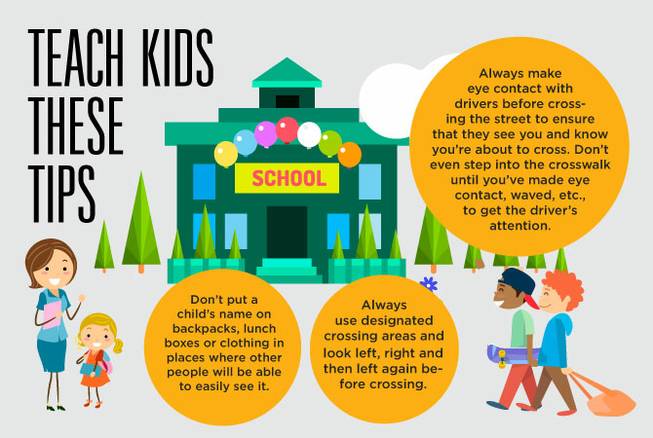
Monday, Aug. 22, 2016 | 2 a.m.
Every day in the United States, an average of 44 kids are hit by cars while walking. As back-to-school time begins, it’s especially important that parents and children are practicing safe habits while getting to and from school.
“Back-to-school can be hectic, so planning ahead and being prepared is very important for avoiding injury. No one wants to end up in the emergency room, especially when it can be avoided,” said Jeanne Marsala, RN, Safe Kids Director at Sunrise Children’s Hospital. Teach your children these safe habits and reinforce them often.
Have a plan
Before school starts, and during the first full week, parents should do “practice” walks with their children to determine the route they’ll take to school and identify safe areas. This could mean the full walk they’ll take to school or the walk they’ll take to the bus stop, depending on how they get to school every day.
“Once you’ve found a safe route, it’s important to identify safe places along that route in the event of an emergency. This could be a neighbor’s house, a gas station, a store or anywhere that the child will be able to get adult help if they need it,” Marsala said.
Be sure that your child is comfortable with the route, knows the safe places well and can confidently walk it alone if they’re old enough. It’s also important that they know to always walk directly to and from school, not to stop in parks or lots and never to take shortcuts.
Another important tip when planning for the school year is to establish a code word with your child in the event that someone else might be picking them up from school. The word should be used so the child can ensure that the person picking them up has been sent by a parent or guardian and is not a stranger.
Should your child be walking alone?
“No child under the age of 10 should be walking to school alone,” Marsala said. This is especially important when crossing the street, because developmentally most children are unable to judge the speed and distance of cars until they’re 10 or older.
Even if children are above the age of 10, parents should consider walking with them as much as possible, or finding them a buddy or group of friends to walk with.
Buses and bus stops
When waiting at the bus stop, children should stand at least three large steps away from the curb and always wait for the bus to make a full stop before approaching. Children should wait in a group, preferably with at least one parent present. Once they’re on the bus, children need to stay seated, never stand up before the bus stops moving, and never stick their hands or heads out the bus windows.
Mobile devices
Being distracted by mobile devices while walking down the street or crossing the road can be very dangerous, and teenagers are especially at risk for this behavior. Be sure that all children and teens put down their phones and other devices when crossing the street, and set a good example by doing so yourself.
If the child has headphones in, Marsala recommends that they always take out at least one earbud when crossing the street so they’re able to hear oncoming traffic.
Walking school buses
Some schools have “walking school bus” programs, in which parents who live nearby walk to the bus stop together with other neighborhood children. Some walking school bus programs also will wait at parks or other public areas and walk children getting off the bus to the school, which helps cut traffic congestion.
Parents should check with school administrators to find out if programs like this exist at their school, and if not, they can consider creating a walking school bus program themselves.
Tips for driving in school zones
• Always slow down and adhere to the rules within the school zone.
• Keep your eyes out for buses, and never pass when their lights are flashing.
• Give children the right of way in crosswalks and school zones.
• Parents should not drop their kids off in traffic and should always have their children exit on the right side of the vehicle.
• Avoid backing up in school zones when possible.
Other important tips to teach children
Be careful when Daylight Savings Time ends, and make sure children are never walking in the dark. If they will be, equip them with reflective gear on their shoes, backpacks and/or other accessories.
Don’t put a child’s name on backpacks, lunch boxes or clothing in places where other people will be able to easily see it.
Always use designated crossing areas and look left, right and then left again before crossing.
Always make eye contact with drivers before crossing the street to ensure that they see you and know you’re about to cross. Don’t even step into the crosswalk until you’ve made eye contact, waved, etc., to get the driver’s attention.

Join the Discussion:
Check this out for a full explanation of our conversion to the LiveFyre commenting system and instructions on how to sign up for an account.
Full comments policy